Custard cakes with custard
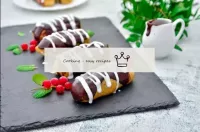 8 servings2 hours
8 servings2 hours
Wheat flour - 150 g, Butter - 100 g, Water - 250 ml, Eggs - 4 pcs., Sugar - 1 tea liter, Salt - 0.5 tea liter, Milk - 650 ml, Eggs - 2 pcs., Sugar - 250 g, Wheat flour - 4 tbsp., Butter - 50 g, Vanillin - to taste
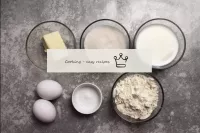
How to make custard cakes with custard? Let's start cooking with the cream, as it will need time to cool down. Prepare the products. Remove the oil from the refrigerator in advance to soften.
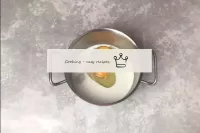
Take a heavy-bottomed saucepan to prevent the cream from sticking when cooking. Pour 150ml of milk into it, pour sugar, break eggs. Stir the ingredients together with a whisk.
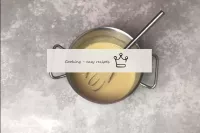
Pour in the flour and vanillin, stir until the lumps are gone.
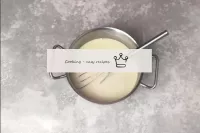
In a separate dish, boil the remaining 500ml of milk. Pour hot milk into the egg mixture in a thin stream, actively stirring with a whisk.
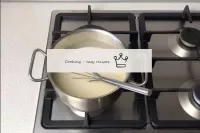
Place the pan on a small heat. Cook the mixture with constant stirring. Eggs can curl and the cream will turn into an omelette, so it is important to interfere with the cream all the time.
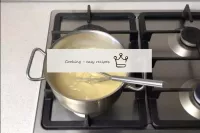
Cook the cream for about 10-15 minutes until thick. Determine the exact time by your stove. The corolla will begin to leave deep marks on the surface. Remove the cream from the heat and leave for a while to cool a little.
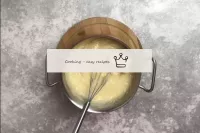
Put the soft butter in the warm cream.
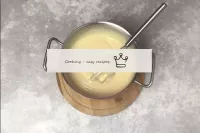
Stir the custard base with the oil until smooth and smooth.
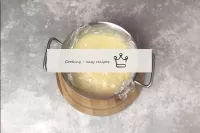
Cover the pan of cream with cling film end-to-end, that is, so that the film lies on its surface. This will prevent the formation of a crust. Leave the cream to cool.

While the cream cools, make the dough. Prepare the products for it. Eggs can leave a different number, from 3 to 5. It will be necessary to look at the consistency of the dough. The same goes for flour.

Grab a thick-bottomed pot. Pour water into it, put butter, sugar and salt.
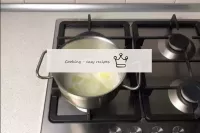
Place the pan over a small heat. Melt the oil and bring the mixture to a boil.
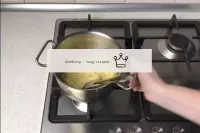
Pour flour into the pan without removing it from the heat. Actively stir the mixture so that the flour mixes well with the liquid. Brew the dough for a couple of minutes with constant stirring. When velvet sediment appears at the bottom, remove the pan from the heat.
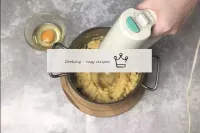
Cool the dough a little. Start driving eggs into it one at a time. I worked as a mixer, but you can stir with a regular shoulder blade. After each egg, stir the mixture well until smooth.
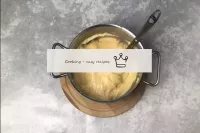
After the third egg, assess the condition of the dough. If it is creamy and flows off the shoulder blade, then do not add a fourth egg. If it's still thick, pour in, but not the whole, but half. You need to achieve the turnover of the test. Therefore, the number of eggs varies, from 3 to 5. It took me 4 category zero eggs.
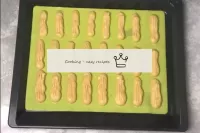
Put the dough in a pastry bag. Cover the baking sheet with parchment or silicone mat. Deposit the cakes on a tube mat, leaving a distance between them as they will grow in size. Use the plug to shape the tubes.
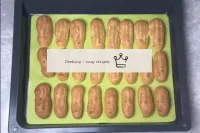
Bake the cakes in the oven at about 200 ° C for 10 minutes, then reduce the heat to 180 ° C and bake for about 30-35 more minutes until golden. Determine the exact time and temperature of baking by your oven. Remove the finished cakes from the baking sheet and cool completely.
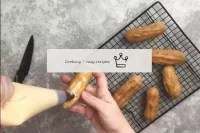
Transfer the cooled cream to a pastry bag. Cut each cake from the side and fill with bag cream. You can squeeze cream into them without a cut, piercing the bottom in several places.
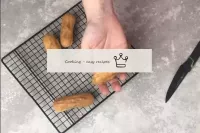
You can decorate the finished cake to your liking. I covered them in chocolate icing. Of this number of products, I got 30 small eclairs.
 8 servings
8 servings After the third egg, assess the condition of the dough. If it is creamy and flows off the shoulder blade, then do not add a fourth egg. If it's still thick, pour in, but not the whole, but half. You need to achieve the turnover of the test. Therefore, the number of eggs varies, from 3 to 5. It took me 4 category zero eggs.
After the third egg, assess the condition of the dough. If it is creamy and flows off the shoulder blade, then do not add a fourth egg. If it's still thick, pour in, but not the whole, but half. You need to achieve the turnover of the test. Therefore, the number of eggs varies, from 3 to 5. It took me 4 category zero eggs.  Español
Español Français
Français Português
Português Русский
Русский 简体中文
简体中文 繁體中文
繁體中文 日本語
日本語 한국어
한국어 العربية
العربية Türkçe
Türkçe Қазақ
Қазақ Deutsch
Deutsch Italiano
Italiano Українська
Українська
 How to make custard cakes with custard? Let's start cooking with the cream, as it will need time to cool down. Prepare the products. Remove the oil from the refrigerator in advance to soften.
How to make custard cakes with custard? Let's start cooking with the cream, as it will need time to cool down. Prepare the products. Remove the oil from the refrigerator in advance to soften.  Take a heavy-bottomed saucepan to prevent the cream from sticking when cooking. Pour 150ml of milk into it, pour sugar, break eggs. Stir the ingredients together with a whisk.
Take a heavy-bottomed saucepan to prevent the cream from sticking when cooking. Pour 150ml of milk into it, pour sugar, break eggs. Stir the ingredients together with a whisk.  Pour in the flour and vanillin, stir until the lumps are gone.
Pour in the flour and vanillin, stir until the lumps are gone.  In a separate dish, boil the remaining 500ml of milk. Pour hot milk into the egg mixture in a thin stream, actively stirring with a whisk.
In a separate dish, boil the remaining 500ml of milk. Pour hot milk into the egg mixture in a thin stream, actively stirring with a whisk.  Place the pan on a small heat. Cook the mixture with constant stirring. Eggs can curl and the cream will turn into an omelette, so it is important to interfere with the cream all the time.
Place the pan on a small heat. Cook the mixture with constant stirring. Eggs can curl and the cream will turn into an omelette, so it is important to interfere with the cream all the time.  Cook the cream for about 10-15 minutes until thick. Determine the exact time by your stove. The corolla will begin to leave deep marks on the surface. Remove the cream from the heat and leave for a while to cool a little.
Cook the cream for about 10-15 minutes until thick. Determine the exact time by your stove. The corolla will begin to leave deep marks on the surface. Remove the cream from the heat and leave for a while to cool a little.  Put the soft butter in the warm cream.
Put the soft butter in the warm cream.  Stir the custard base with the oil until smooth and smooth.
Stir the custard base with the oil until smooth and smooth.  Cover the pan of cream with cling film end-to-end, that is, so that the film lies on its surface. This will prevent the formation of a crust. Leave the cream to cool.
Cover the pan of cream with cling film end-to-end, that is, so that the film lies on its surface. This will prevent the formation of a crust. Leave the cream to cool.  While the cream cools, make the dough. Prepare the products for it. Eggs can leave a different number, from 3 to 5. It will be necessary to look at the consistency of the dough. The same goes for flour.
While the cream cools, make the dough. Prepare the products for it. Eggs can leave a different number, from 3 to 5. It will be necessary to look at the consistency of the dough. The same goes for flour.  Grab a thick-bottomed pot. Pour water into it, put butter, sugar and salt.
Grab a thick-bottomed pot. Pour water into it, put butter, sugar and salt.  Place the pan over a small heat. Melt the oil and bring the mixture to a boil.
Place the pan over a small heat. Melt the oil and bring the mixture to a boil.  Pour flour into the pan without removing it from the heat. Actively stir the mixture so that the flour mixes well with the liquid. Brew the dough for a couple of minutes with constant stirring. When velvet sediment appears at the bottom, remove the pan from the heat.
Pour flour into the pan without removing it from the heat. Actively stir the mixture so that the flour mixes well with the liquid. Brew the dough for a couple of minutes with constant stirring. When velvet sediment appears at the bottom, remove the pan from the heat.  Cool the dough a little. Start driving eggs into it one at a time. I worked as a mixer, but you can stir with a regular shoulder blade. After each egg, stir the mixture well until smooth.
Cool the dough a little. Start driving eggs into it one at a time. I worked as a mixer, but you can stir with a regular shoulder blade. After each egg, stir the mixture well until smooth.  Put the dough in a pastry bag. Cover the baking sheet with parchment or silicone mat. Deposit the cakes on a tube mat, leaving a distance between them as they will grow in size. Use the plug to shape the tubes.
Put the dough in a pastry bag. Cover the baking sheet with parchment or silicone mat. Deposit the cakes on a tube mat, leaving a distance between them as they will grow in size. Use the plug to shape the tubes.  Bake the cakes in the oven at about 200 ° C for 10 minutes, then reduce the heat to 180 ° C and bake for about 30-35 more minutes until golden. Determine the exact time and temperature of baking by your oven. Remove the finished cakes from the baking sheet and cool completely.
Bake the cakes in the oven at about 200 ° C for 10 minutes, then reduce the heat to 180 ° C and bake for about 30-35 more minutes until golden. Determine the exact time and temperature of baking by your oven. Remove the finished cakes from the baking sheet and cool completely.  Transfer the cooled cream to a pastry bag. Cut each cake from the side and fill with bag cream. You can squeeze cream into them without a cut, piercing the bottom in several places.
Transfer the cooled cream to a pastry bag. Cut each cake from the side and fill with bag cream. You can squeeze cream into them without a cut, piercing the bottom in several places.  You can decorate the finished cake to your liking. I covered them in chocolate icing. Of this number of products, I got 30 small eclairs.
You can decorate the finished cake to your liking. I covered them in chocolate icing. Of this number of products, I got 30 small eclairs. 